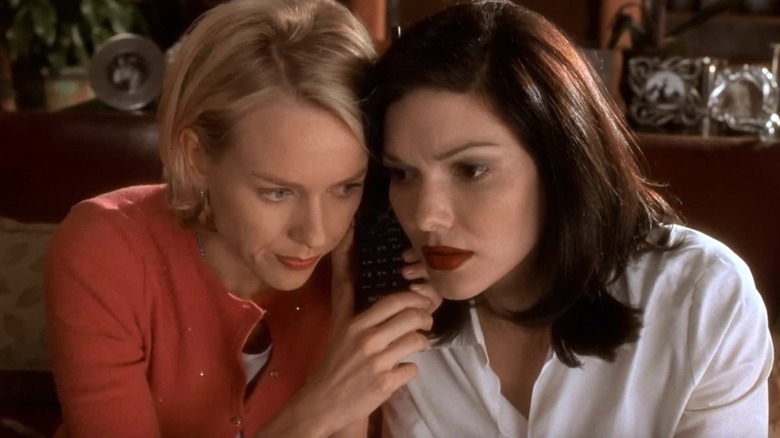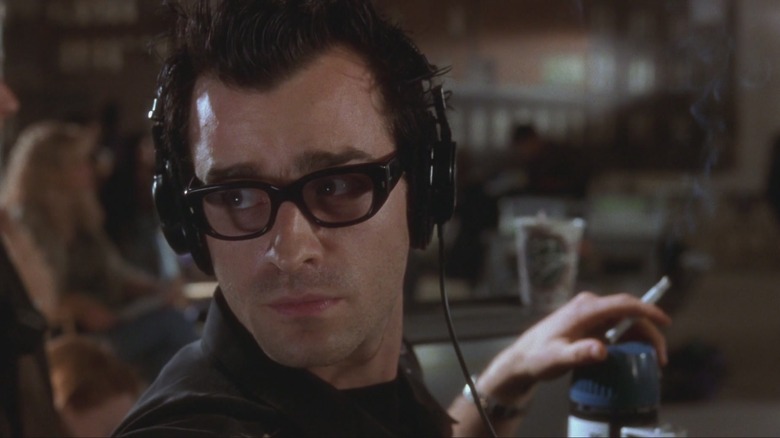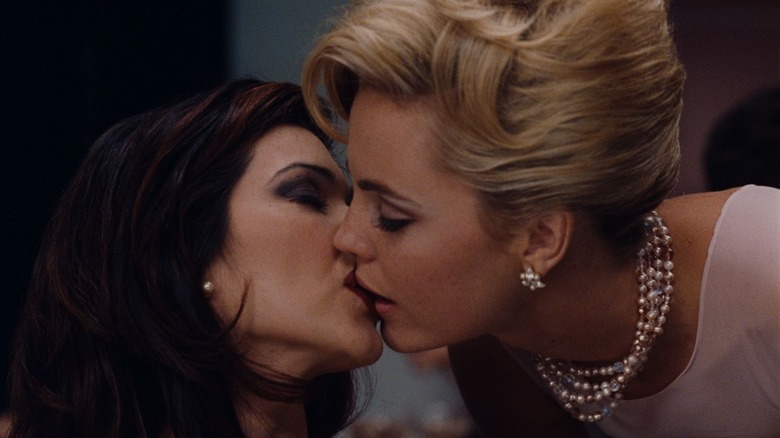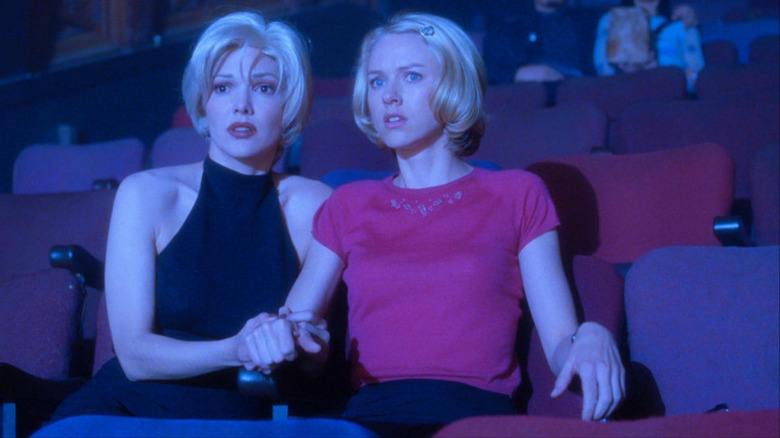The Twisting Timeline Of David Lynch's Mulholland Drive Explained
The DVD of David Lynch's 2001 mystery "Mulholland Drive" came with a mystery of its own. Those who know David Lynch know that he loathes talking about his movies, and staunchly refuses to answer bothersome questions about their meaning. This is the man who famously declared his 1977 classic "Eraserhead" to be his most spiritual film. When asked to elucidate, Lynch simply said "No." For Lynch, all the answers are up on the screen. Any commentary is not only redundant but distracting; why watch a movie looking for an interpretation when one can simply experience it raw? This is why Lynch has never provided a commentary track for any of his movies, and why he hates chapter stops on DVDs and Blu-rays. Sit in a dark room, he says, and let the film enter your mind unadulterated.
This is why the paper insert in the 2002 "Mulholland Drive" release is so baffling. David Lynch famously authored a list of 10 "clues" that the layperson could follow to "unlock" the meaning of "Mulholland Drive." This is wholly out of character for Lynch, and antithetical to the way he typically thinks. Lynch would later reveal in a 2018 interview with Vulture that the list of clues was only meant to be released in France.
The clues, perhaps naturally, are just as baffling as the movie. One of them is simply "Who gives a key, and why?" Perhaps Lynch was cheekily wielding the clue sheet, using them to deepen the mysteries of "Mulholland Drive," not unlock them. There have, of course, been many interpretations of the meaning of "Mulholland Drive," although those will always be arguable. If one wants to be more literal about what's on the screen, there is a way to suss out the film's chronology ... kind of.
The clue sheet
The clue sheet runs thus, and please don't expect it to help.
- Pay particular attention in the beginning of the film: At least two clues are revealed before the credits.
- Notice appearances of the red lampshade.
- Can you hear the title of the film that Adam Kesher is auditioning actresses for? Is it mentioned again?
- An accident is a terrible event — notice the location of the accident.
- Who gives a key, and why?
- Notice the robe, the ashtray, the coffee cup.
- What is felt, realized and gathered at the Club Silencio?
- Did talent alone help Camilla?
- Note the occurrences surrounding the man behind Winkie's.
- Where is Aunt Ruth?
Lynch confirmed that the clues were indeed real, and he wanted them to be read in Europe merely because, in his mind, Europe was so very far away. Yes, that was his explanation. "I came up with things that people could think about when they watched it," he said.
The clues don't seem like they'd be much of a help when sussing out a timeline of events, although the website Mulholland-Drive.net has done a deep dive, finding that the clues actually do unlock the order of certain events. Before the credits, it points out, the audience sees a jitterbug contest which is interpreted as the dance competition that Betty/Diane (Naomi Watts) won, leading to her need to move to Hollywood and become an actress. That would be the first event in the movie.
It's not revealed until late in the film, but the first two-thirds of the movie is a dream sequence wherein Diane dreams that she is an innocent named Betty, living out an idealized fame fantasy. Diane is actually the jilted lover of Camilla (Laura Harring), an actress who left her for multiple other lovers.
Betty is actually Diane
Because of the dream sequence reveal, one can indeed unlock the meaning of the Betty sequences of the movie as dream-like "remixes" of Diane's actual reality ... if one wants to see it that way; I'm not declaring anything definitive. Mulholland-Drive.net, however, does point out that the opening sequence features images of a pillow, meaning we're about to see a dream.
Importantly, some of the action of "Mulholland Drive" is cyclical, sort of like "Finnegans Wake." The "end" of a part of the story will link up with the beginning. The inciting incident of "Mulholland Drive" is an accident on the titular road wherein Camilla (but not Diane) is injured and loses her memory. She wanders, dazed, down to a Hollywood apartment where she meets Betty, the innocent dream version of Diane. We'll later learn that Camilla has wandered into Diane's dream.
Late in the film, we see the events that led up to the accident. In order: Diane moves to Hollywood to become an actress. She meets and falls in love with Camilla, a vampish bisexual femme fatale. Diane is depressed and a little mentally unstable and is moved to despair when she learns that Camilla has been carrying on an affair with a director (Justin Theroux).
Camilla, we learn, is an intense lover, but eventually rebuffs Diane, saying "We can't do this anymore." Camilla seems determined to remain in the closet and marry a man, largely so she can survive in Hollywood. Camilla also decides that she wants a female lover on the side, but to Diane's chagrin, Camilla has selected a pretty blonde played by Melissa George.
The beginning, the end
Diane, bitter and angry, arranges for Camilla's car to crash, hoping to kill her. Camilla survives.
The film then spins a wheel of identity, and the names become jumbled between the characters. In Diane's dream, Camilla becomes an amnesiac Diane (who initially named herself after Rita Hayworth). Diane becomes Betty, a new, innocent version of herself. The mysterious blonde is now named Camilla. The glorious illusions of Hollywood can protect them. It's all fake — just like Hollywood — but it's all beautiful — just like Hollywood. The most telling scene in "Mulholland Drive" is when Betty and "Diane" go to a theater downtown and witness a beautiful musical act wherein all the sound is pre-recorded. It's all deeply moving and it's all artificial.
As the dream progresses, however "Betty" begins to see cracks in her somnambulist fantasies. The name Betty shows up on the nametag of a random waitress. The two women break into an apartment, hoping to discover "Diane's" true identity, and find a dead body lying in bed. Naturally, that dead body is the real Diane, dreaming of her corpse. The film then progresses back to the "reality" sequence wherein Diane is herself, recalling the pain that led to her dream.
The last word of dialogue is "Silencio," whispered in the above theater. One might think that word was the final breath leaving Diane's body. The movie is about a despondent woman coming to L.A. to act, falling in with a vindictive girlfriend, having her heart broken, arranging her death, and then going to bed once the deed is done. She then dreamed of an ideal life. The dream, however, became a nightmare, and she died in her sleep, perhaps by her own hand.
It's as good an interpretation as any.



